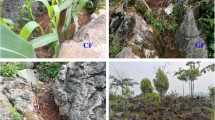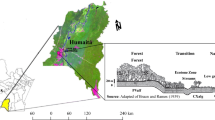Abstract
Near-surface karst fissures are filled with soils. These soils are often derived from the erosion and transport of surface soil but have different properties than the surface soil in karst rocky desertification regions. This study was undertaken to determine the soil structure and nutrient contents in underground fissures with different grades of rocky desertification (no, potential, mild, moderate and severe). Based on field surveys, near-surface karst fissures were selected in a typical karst plateau area. Soil particle compositions, particularly nutrient characteristics, were determined through field sampling and laboratory experiments. The results indicated that the higher the rock desertification grade was, the higher the soil sand (0.02–2 mm) content and the lower the clay (< 0.002 mm) content. The soil in both limestone and dolomite fissures was basically neutral to weakly alkaline. The surface soil in dolomite fissures presented a higher soil organic matter content than that in limestone fissures, but the opposite was true for the subsurface soil. From the surface to the lower layer, the total nitrogen content generally decreased, and the total phosphorus content generally decreased in dolomite fissures but exhibited a more complex pattern in limestone fissures. The total phosphorus content of the surface soil was higher than that of the subsurface soil, but the total potassium content was lower. There was no significant difference among different soil layers. Near-surface fissures are a good place to promote vegetation restoration projects, because they provide good soil structure and nutritional conditions for plant growth.





Similar content being viewed by others
References
Auler AS, Smart PL (2003) The influence of bedrock-derived acidity in the development of surface and underground karst: evidence from the Precambrian carbonates of semi-arid northeastern Brazil. Earth Surf Proc Land 28:157–168
Dai Q, Peng X, Yang Z, Zhao L (2017a) Runoff and erosion processes on bare slopes in the karst rocky desertification area. Catena 152:218–226
Dai Q, Peng X, Zhao L, Shao H, Yang Z (2017b) Effects of underground pore fissures on soil erosion and sediment yield on karst slopes. Land Degrad Dev 28:1922–1932
Fu YH, Huang ZS, Yu LF, Yang R (2012) Analysis on the soil quality of different typical underground root habitat types in karst areas. Res Soil Water Conserv 19(3):67–73
Institute of Soil Science of Chinese Academy of Sciences, (1978) Soil chemical and physical analysis. Shanghai Science and Technology Press, Shanghai (in Chinese)
Jiang ZC, Luo WQ, Deng Y, Cao J, Qin X, Li Y, Yang Q (2014) The leakage of water and soil in the karst peak cluster depression and its prevention and treatment. Acta Geosci Sin 35(5):535–542 (in Chinese)
Lei L, Wei XH, Xu XZ, Zhou HY (2013) Vertical distribution of migration channels and grain-size change features of soil in karst mountainous areas of northern Guangdong. Geogr Res 32(12):2204–2214 (in Chinese)
Li HX (2006) Preliminary study of soil profiles features in karst fracture and its evolution characteristics. Xi’an University of Science and Technology, Xi’an (in Chinese)
Li CL, Dai QH, Peng XD, Yuan YF (2016) Characteristics of nitrogen, phosphorus and potassium losses in underground runoff of karst slope farmlands during the developing process of shallow karst fissure. Acta Sci Circum 36(12):4437–4445 (in Chinese)
Liu SJ, Zhang W, Wang KL, Chen H, Wei G (2010) Spatiotemporal heterogeneity and its formation causes of soil physical properties in karst peak-cluster depression area of northwest Guangxi, China. Chin J Appl Ecol 21(9):2249–2256
Long J, Juan LI, Deng QQ, Li YB, Xiong KN (2006) Soil properties and fractal features in the rocky desertification process of karst regions, Guizhou Province. Chin J Soil Sci 37(4):635–639
Miko S, Koch G, Mesić S, Miko MS, Šparica M, Vreča P, Dolenec T (2006) Influence of land use in small karst watersheds on the chemical status of peloid sediments on the eastern Adriatic coast. J Soils Sediments 7(5):303–312
Ni HQ, Lu CJ, Gan FP, Yu LP, Gan WH (2014) CT identification of karst rock structure damage and diagnosis, forecasting and early warning of ground collapse and water inrush in tunnel: a case study of Yangpeng tunnel of Beijing-Zhuhai expressway in Northern Guangdong. Chin J Rock Mechan Eng 33(4):763–771
Nie YP, Chen HS, Wang KL, Yang J (2012) Water source utilization by woody plants growing on dolomite outcrops and nearby soils during dry seasons in karst region of Southwest China. J Hydrol 420(4):264–274
Peng XD, Dai QH, Yang Z, Zhao LS (2016) Sediment yield of surface and underground erosion in the process of rocky desertification of karst area. Acta Pedol Sin 53(5):1237–1248 (In Chinese)
Peng X, Dai Q, Li C, Yuan Y, Zhao L (2017) Effect of simulated rainfall intensities and underground pore fissure degrees on soil nutrient loss from slope farmlands in karst region. Trans Chin Soc Agric Eng 33(2):131–140
Qu YH (1991) Fracture network interconnectivity of the carbonate rock and its control over karst in Xishan, Beijing. Earth Sci J China Univ Geosci 16(01):71–77 (in Chinese)
Sarkar D (2005) Physical and chemical methods in soil analysis. New Age International, New Delhi
Sweeting MM (1993) Reflections on the development of karst geomorphology in Europe and a comparison with its development in China. Z Geomorph 37:127–138
Tang Y, Sun K, Zhang X, Zhou J, Yang Q, Liu Q (2016) Microstructure changes of red clay during its loss and leakage in the karst rocky desertification area. Environ Earth Sci 75(6):537
Wang SY, Kuang SD, Dai CG, Wang MZ, Liu JR (2009) Analyses on the reason of rocky desertification speed difference of dolomite and limestone in mountain area. Guizhou Geol 26(1):49–51 (in Chinese)
Wang PJ, Dai QH, Ding GJ, Cheng FD (2012) Fractal features of soil during the process of vegetation recovery in karst region. J Soil Water Conserv 26(4):178–182 (in Chinese)
Wang PJ, Dai QH, Ding GJ, Cheng FD (2014) Variation of soil anti-erodibility during restoration of degraded karst vegetation. Acta Pedol Sin 51(3):806–815
Williams PW (2008) The role of the epikarst in karst and cave hydrogeology: a review. Int J Speleol 37(1):1–10
Williams LJ, Abdi H (2010) Fisher’s least significant difference (LSD) test. In: Salkind N (ed) Encyclopedia of research design. Sage, Thousand Oaks, pp 1–5
Wu M, Liu SJ, Ye YY, Zhang W, Wang KL, Chen HS (2015) Spatial heterogeneity and storage assessment method of surface soil organic carbon in high bulk-rock ratio slopes of Karst Regions. Chin J Eco-Agric 6:676–685 (in Chinese)
Yan Y, Dai Q, Wang X, Jin L, Mei L (2019) Response of shallow karst fissure soil quality to secondary succession in a degraded karst area of southwestern China. Geoderma 348(15):76–85
Yang Q, Zhang F, Jiang Z, Li W, Zhang J, Zeng F, Li H (2014) Relationship between soil depth and terrain attributes in karst region in Southwest China. J Soils Sediments 14(9):1568–1576
Zhang X, Bai X, He X (2011) Soil creeping in the weathering crust of carbonate rocks and underground soil losses in the karst mountain areas of southwest China. Carbonates Evaporates 26(2):149–153
Acknowledgments
This work was supported by the first class discipline construction projects of Guizhou Province (GNYL[2017]007), the National Key Research and Development Program of China (2016YFC0502604), the National Natural Science Foundation of China (Nos. 41671275, 41461057), the Major Project of Guizhou Province (Qian Ke He Major Project [2016]3022, Qian Ke He Platform talent [2017]5788), the High level Innovative Talents in Guizhou Province (Qian Ke He Platform Talents [2018]5641) and the Research Projects of Introducing Talents in Guizhou University (Gui Da Ren Ji He Zi (2018)49).
Author information
Authors and Affiliations
Contributions
XP and QD designed the study and wrote the manuscript. XW and CL carried out all the tests and collected the data. GD provided valuable guidance. All authors reviewed the manuscript.
Corresponding author
Ethics declarations
Conflict of interest
There are no conflicts of interest regarding the paper.
Additional information
Publisher's Note
Springer Nature remains neutral with regard to jurisdictional claims in published maps and institutional affiliations.
Rights and permissions
About this article
Cite this article
Peng, X., Wang, X., Dai, Q. et al. Soil structure and nutrient contents in underground fissures in a rock-mantled slope in the karst rocky desertification area. Environ Earth Sci 79, 3 (2020). https://doi.org/10.1007/s12665-019-8708-z
Received:
Accepted:
Published:
DOI: https://doi.org/10.1007/s12665-019-8708-z




